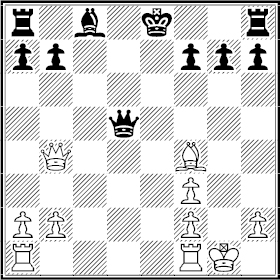
When the only minor pieces are bishops of opposite color, a middlegame attack is more likely to succeed.
Mikhail Tal White
Jan Timman Black
Reykjavik 1988
Queen’s Gambit Declined D32
1 ♘f3 ♘f6 2 c4 c5 3 ♘c3 ♘c6 4 e3 e6 5 d4 d5 6 cxd5 exd5 7 ♗e2 cxd4 8 exd4
The best way for either side to seek an advantage is ...♘e4 or ♘e5. For example, 8...♗e7 9 0-0 0-0 10 ♘e5! since 9...♘xe5? 10 dxe5 loses a pawn.
8...♘e4 9 0-0 ♗b4 10 ♘xe4 dxe4 11 d5! exf3 12 ♗xf3 ♘e5 13 ♕a4+ ♕d7 14 ♕xb4 ♘xf3+ 15 gxf3 ♕xd5 16 ♗f4

White is looking for a knockout blow on a dark square where he is strong because of his unopposed bishop. For example, 16...♕xf3? 17 ♖fe1+ ♗e6 18 ♗g5!.
16...♗e6! 17 ♖fe1
But Black might counter-attack on light squares. With 17 ♖ac1 White prepares 18 ♖c7. But 17...a5! 18 ♕b6 0-0 threatens ...♕xf3/...♗h3.
17...a5 18 ♕a3! ♖c8
Uncastled, Black is in trouble.
Question 389: What happens after 18...f6 (and ...♔f7) 19 ♖ad1 ♕f5 ?
19 ♖ad1! ♕c5?
Also lost was 19...♕f5? 20 ♕d6! and wins with 21 ♕d7+ but 19...♕b5 offered survival chances.
20 ♖c1! resigns.
Black drops a rook (20...♕xa3 21 ♖xc8+ ♔d7 22 ♖c7+! and 23 bxa3).
Andras Biro White
Joszef Gaber Black
Hungary 1998
1 e4 c6 2 d4 d5 3 exd5 cxd5 4 c4 ♘f6 5 ♘c3 e6 6 ♘f3 ♗e7 7 cxd5 exd5 8 ♘e5! 0-0 9 ♗e2 ♘c6 10 0-0 ♕b6 11 ♘a4 ♕a5? 12 ♗d2 ♗b4 13 ♗f4 ♗f5 14 ♘xc6 bxc6 15 ♖c1 ♗d7 16 a3 ♗e7 17 b4 ♕d8 18 ♗a6 ♗c8 19 ♖xc6 ♗xa6 20 ♖xa6 ♕c8 21 ♕d3 ♘e4 22 f3 ♘g5 23 ♖c1 ♕e8 24 ♘c5 ♗xc5 25 dxc5 f6 26 c6 ♔h8 27 c7 ♘f7 28 ♕xd5 g5 29 ♖e6 resigns.